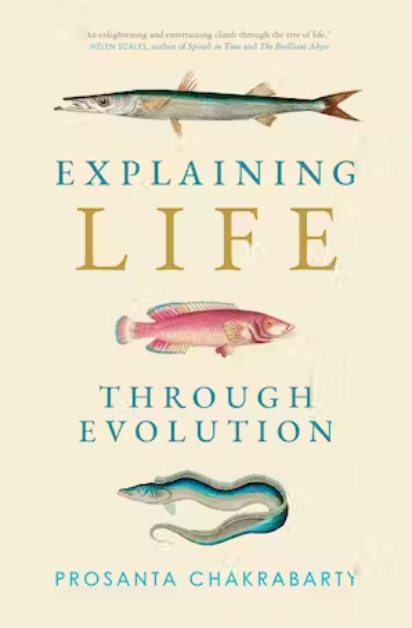The primary goal of most popular books on evolution is to walk the reader through a logical, reasonable, engaging, and evidence-based explanation of the diversification of living things. Especially given the social controversies surrounding evolution, it is easy for such books to be, or come across as, combative, thus backfiring with a segment of the very audience they are hoping to convince. In Exploring Life through Evolution, Louisiana State University evolutionary biologist Prosanta Chakrabarty seeks to meet those with doubts about evolution where they are, as if inviting them to a conversation. The easy-to-read and bite-sized chapters coupled with his unpretentious and playful tone and his attention to topical issues involving evolution allow him to accomplish this objective through most of the book — but it sometimes comes at a cost.
 The book begins with “A Personal Prologue,” four short chapters describing Chakrabarty’s own experience learning about evolution while also explaining what science is and how it works. Chakrabarty is at his best here. I was engaged by his empathetic writing style, which he probably honed during his years of teaching college evolutionary biology in the Deep South. Chakrabarty adroitly explains that skepticism is an essential component of the scientific process, but invites the reader to extend him “a bit of trust” as he describes how we have come to our current understanding of evolution. Parts II and III, “The Evolution Revolution” and “Questions and Misconceptions,” make up the bulk of the book. These parts provide the understanding of evolution that Chakrabarty hopes to instill in his readers. The order of these two sections is effective: first present the audience with the facts behind the phenomena and only then tackle the most common misunderstandings about and misdirected challenges to evolution.
The book begins with “A Personal Prologue,” four short chapters describing Chakrabarty’s own experience learning about evolution while also explaining what science is and how it works. Chakrabarty is at his best here. I was engaged by his empathetic writing style, which he probably honed during his years of teaching college evolutionary biology in the Deep South. Chakrabarty adroitly explains that skepticism is an essential component of the scientific process, but invites the reader to extend him “a bit of trust” as he describes how we have come to our current understanding of evolution. Parts II and III, “The Evolution Revolution” and “Questions and Misconceptions,” make up the bulk of the book. These parts provide the understanding of evolution that Chakrabarty hopes to instill in his readers. The order of these two sections is effective: first present the audience with the facts behind the phenomena and only then tackle the most common misunderstandings about and misdirected challenges to evolution.
I was impressed with Part II’s different approaches to explaining how evolution works, including myriad ways to depict the tree of life, complete with color versions that I suspect come directly from teaching materials he has developed and refined over the years. I particularly liked Figure 6 and its exploding firework design with little drawings that represent the evolution of the major groups of organisms. These bursts of adaptation and speciation are a clever visualization I had not seen before. Also noteworthy is a chapter consisting of a clever and non- confrontational illustrated story of Darwin and Wallace’s independent discovery of natural selection, which charmed my art-major daughter, home from college for Thanksgiving.
But Chakrabarty’s attempts at simplicity sometimes backfire. My daughter, with only a year of biology in high school and a semester in college, complained that a chapter on the history of life misleadingly talked about microbes as learning and inventing. Here and elsewhere, Chakrabarty unnecessarily and misleadingly ascribes agency where none exists. Similarly, when he writes “so many of our body parts evolved for use in water” (page 28) and “Tiktaalik and other early lobe-finned fishes evolved thicker fin bones for fighting gravity” (page 104), he seems to fall into the trap of teleology, failing to recognize, much less to challenge, the common misconception that evolution is goal-oriented, with new traits arising in order to promote survival and reproduction, or even speciation.
The book ends with “Why Understanding Evolution Matters”: five short chapters plus a fictitious and somewhat unbelievable barstool conversation between the author and a creationist. While I was hoping for a strong finish addressing important topical issues to which evolution is relevant, like gene editing, natural history, genealogy versus ancestry, and sex versus gender, I quickly lost interest — and patience.
For example, the “Evolution in the Anthropocene” chapter starts with a spirited indictment of dog breeding (Chakrabarty calls it “forced incest”; I agree) but then quickly transitions to a surprising rant about the dangers of the new CRISPR-Cas9 gene editing technology. Here Chakrabarty even goes as far as to speculate that the release of disease-resistant mosquitoes could end up sterilizing people, a claim that is more cable news click-bait than responsible science journalism. Worse, it’s counterproductive: his overstated warnings about the technology might be taken as a reason to distrust science and scientists. For many, learning about one potential harmful use of science is all they need to decide to disregard decades’ worth of scientific research.
Overall Chakrabarty has made a noble attempt at perhaps the most difficult task a scientist faces: explaining evolution to the skeptical non-scientist. However, he falls into the classic traps of oversimplifying to the point of reinforcing the very misconceptions he hopes to correct and overemphasizing topical issues to the point of losing track of the project.







